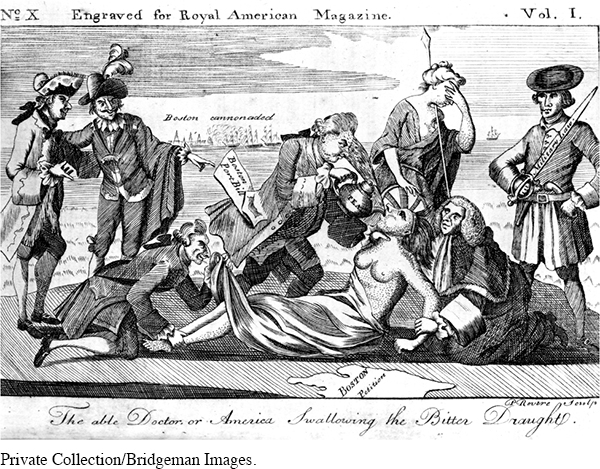The American Promise: Printed Page 156
The American Promise, Value Edition: Printed Page 144
The American Promise: A Concise History: Printed Page 168
Beyond Boston: Rural New England
The Coercive Acts fired up all of New England to open insubordination. With a British general occupying the Massachusetts governorship and some three thousand troops controlling Boston, the revolutionary momentum shifted from urban radicals to rural farmers who protested in dozens of spontaneous, dramatic showdowns. Some towns found creative ways to get around the Massachusetts Government Act’s prohibition on town meetings, and others just ignored the law. Governor Gage’s call for elections for a new provincial assembly under his control sparked the formation of a competing unauthorized assembly that met in defiance of his orders. In all Massachusetts counties outside Boston, crowds of thousands of armed men converged to prevent the opening of county courts run by crown-
The American Promise: Printed Page 156
The American Promise, Value Edition: Printed Page 144
The American Promise: A Concise History: Printed Page 168
Page 157Unfettered by the crown, ordinary citizens throughout New England began serious planning for the showdown everyone assumed would come. Town militias stockpiled gunpowder “in case of invasion.” Militia officers repudiated their official chain of command to the governor and stepped up drills of their units. Town after town withheld its tax money from the royal governor and diverted it to military supplies. Governor Gage felt under heavy threat, but he could do little. He wrote London begging for troop reinforcements, and he beefed up fortifications around Boston. But without more soldiers, his options were limited. Seizing the stockpiles of gunpowder was his best move.
The Powder Alarm of September 1 showed just how ready the defiant Americans were to take up arms against Britain. Gage sent troops to a town just outside Boston reported to have a hidden powder storehouse, and in the surprise and scramble of the attack, false news spread that the troops had fired on men defending the powder, killing six. Within twenty-

The American Promise: Printed Page 156
The American Promise, Value Edition: Printed Page 144
The American Promise: A Concise History: Printed Page 168
Page 159All this had occurred without orchestration by Boston radicals, Gage reported. But British leaders found it hard to believe, as one put it, that “a tumultuous Rabble, without any Appearance of general Concert, or without any Head to advise, or Leader to conduct” could pull off such effective resistance. Repeatedly in the years to come, the British would seriously underestimate their opponents.